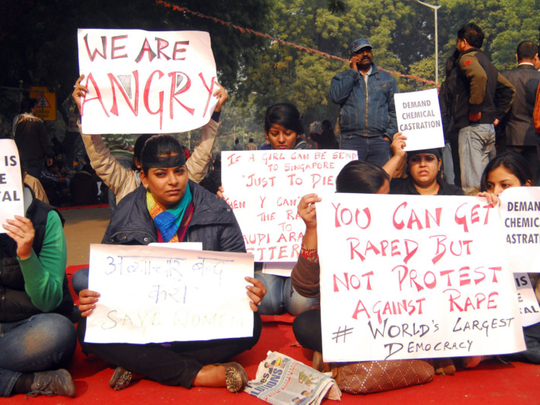
Last Friday a Delhi court dismissed an appeal to revoke the ban on ‘India’s Daughter’, a BBC documentary on the gruesome gang rape of a young woman in Delhi on December 16, 2012. The Indian government had banned its telecast in March last year. The government felt that the documentary, which contained interviews with the rapists and their lawyers and revealed their noxious views about women, would “defame” India in the eyes of the world.
That argument was as bizarre then as it is now. For it doesn’t take a BBC documentary to paint India as a country where rape has become endemic. According to latest data from The National Crime Records Bureau, there were 36,735 cases of rape in the country in 2014, up from 33,707 in 2013. Open a newspaper on any given day and multiple reports of rape, sexual assault or stalking tumble out. The sheer volume of these incidents gives rise to an almost shrugging acceptance of them, as if rape were a systemic problem, an unshakeable part of India’s social and cultural landscape.
A recent case illustrates the casual violence with which rapes are committed in India today. On the night of July 29 a woman and her 14-year-old daughter were gang-raped by a band of robbers. The goons waylaid the family as they were travelling by car through the state of Uttar Pradesh. Rape was an adjunct to the looting — almost a mandatory sideshow to the main event.
The Bulandshahr rape, as it is being called, sparked extensive media coverage. Reports also emerged that in the small towns of north India “rape videos” were hot-selling merchandise. The videos, shot during real life acts of rape, sell for anything between Rs50 to Rs150 a pop, and are loaded into customers’ phones or pen drives. This is porn with a vicious twist, and, of course, it’s all for real.
If rape is an act of sexual violence, rape videos represent its intent. They feed into the urge to see a woman violently subjugated, cowering and helpless, and utterly at the mercy of her tormentors. And if the rising graph of rape is anything to go by, this urge seems to be at an all time high.
To be sure, many more instances of rape are reported in the country now than they were a decade ago. But that alone does not account for the overwhelming tide of violent crimes against women.
The staggering rape numbers must be seen in the context of the fact that many Indian women are breaking every glass ceiling imaginable — from flying fighter jets to rising to the top of their professions. True, the big achievers are still a tiny minority, but they are lighting the path to legions of girls and women who are getting an education and dreaming of economic independence. They want to exercise their free will in matters of work, dress, love and marriage. Many of them are already doing so.
Rape, and indeed, any form of violence against women, is the attempt to pull women back from that track. It is Indian patriarchy’s brutal backlash against women who are stepping out of their traditional societal roles and asserting their right to choose what they want to do with their lives. Go back to the “safety” of your homes, a threatened patriarchy seems to be telling us. Step out of line, and you will be violated and crushed.
Witness the comments Indian politicians, often the loudest and most influential voices of patriarchy, routinely make regarding the crime of rape. In 2014, Nationalist Congress Party leader Asha Mirje said, “Did Nirbhaya (the victim of the December 2012 gang rape) really have to go to watch a movie at 11 in the night with her friend?” Samajwadi Party supremo Mulayam Singh Yadav once dismissed rape as a “mistake” boys make, as if it were a trivial offence. In 2013 Kailash Vijayvargiya, a minister in the state of Madhya Pradesh, said, “If the limit of morality is crossed by women, such cases will happen.”
Each of these remarks suggests that a woman who tries to break out of traditional notions of “morality” and “virtue” and makes her own choices about how she dresses, whom she goes out with and when, is only asking to be raped. Or better still, murdered.
Mukesh Singh, one of Nirbhaya’s rapists, mouths the same revolting logic in ‘India’s Daughter’ — that the victim was to blame because she was wearing the “wrong” clothes and was out with a boy late in the night. And the same mindset is at work when khap panchayats, or village councils, decree the murder of girls who love or marry outside the rules laid down by patriarchy.
The average rapist does not know lofty words like “patriarchy”. But he instinctively participates in its regressive narrative that a woman must be “shown her place”, that if she is bending the rules, she must be bludgeoned into submission. The rising incidence of rape in India is really patriarchy’s furious roar against shifting social mores, against perceived loss of power and authority. The good thing is that the change is inexorable. Rape or not, women are breaking free. Patriarchy will simply have to get used to it.
Shuma Raha is a senior journalist based in Delhi










